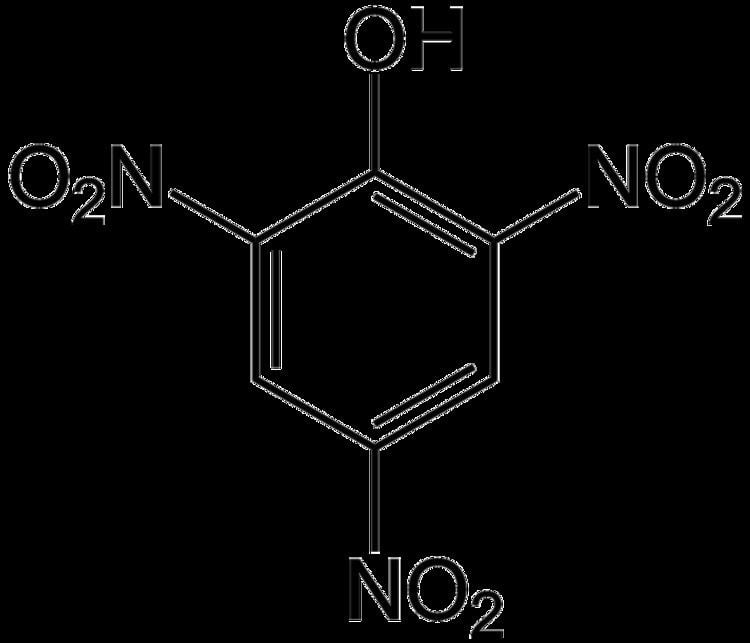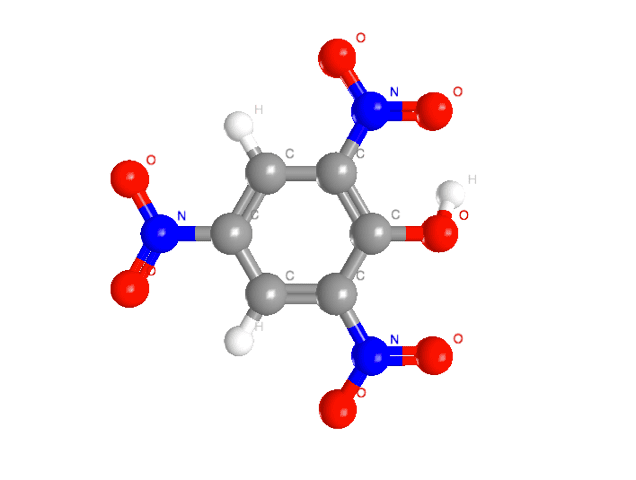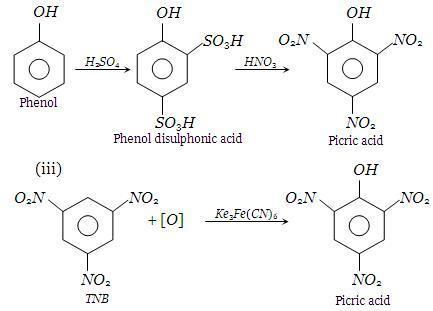Formula C6H3N3O7 Density 1.76 g/cm³ | Molar mass 229.1 g/mol | |
 | ||
Appearance Colorless to yellow solid | ||
Picric acid
Picric acid is an organic compound with the formula (O2N)3C6H2OH. Its IUPAC name is 2,4,6-trinitrophenol (TNP). The name "picric" comes from the Greek πικρός (pikros), meaning "bitter", reflecting its bitter taste. It is one of the most acidic phenols. Like other highly nitrated organic compounds, picric acid is an explosive, which was once its primary use. It has also been used in medicine (antiseptic, burn treatments) and dyes.
Contents

History

Picric acid was probably first mentioned in the alchemical writings of Johann Rudolf Glauber in 1742. Initially, it was made by nitrating substances such as animal horn, silk, indigo, and natural resin, the synthesis from indigo first being performed by Peter Woulfe in 1771. Its synthesis from phenol, and the correct determination of its formula, were successfully accomplished in 1841. Not until 1830 did chemists think to use picric acid as an explosive. Before then, chemists assumed that only the salts of picric acid were explosive, not the acid itself. In 1871 Hermann Sprengel proved it could be detonated and most military powers used picric acid as their main high explosive material. Picric acid is also used in the analytical chemistry of metals, ores, and minerals.
Picric acid was the first high explosive nitrated organic compound widely considered suitable to withstand the shock of firing in conventional artillery. Nitroglycerine and guncotton were available earlier but shock sensitivity sometimes caused detonation in the artillery barrel at the time of firing. In 1885, based on research of Hermann Sprengel, French chemist Eugène Turpin patented the use of pressed and cast picric acid in blasting charges and artillery shells. In 1887 the French government adopted a mixture of picric acid and guncotton under the name Melinite. In 1888, Britain started manufacturing a very similar mixture in Lydd, Kent, under the name Lyddite. Japan followed with an "improved" formula known as shimose powder. In 1889, a similar material, a mixture of ammonium cresylate with trinitrocresol, or an ammonium salt of trinitrocresol, started to be manufactured under the name ecrasite in Austria-Hungary. By 1894 Russia was manufacturing artillery shells filled with picric acid. Ammonium picrate (known as Dunnite or explosive D) was used by the United States beginning in 1906. However, shells filled with picric acid become highly unstable if the compound reacts with metal shell or fuze casings to form metal picrates which are more sensitive than the parent phenol. The sensitivity of picric acid was demonstrated in the Halifax Explosion. Picric acid was used in the Battle of Omdurman, Second Boer War, the Russo-Japanese War, and World War I. Germany began filling artillery shells with TNT in 1902. Toluene was less readily available than phenol, and TNT is less powerful than picric acid, but improved safety of munitions manufacturing and storage caused replacement of picric acid by TNT for most military purposes between the World Wars.

Efforts to control the availability of phenol, the precursor to picric acid, emphasize its importance in World War I. Germans are reported to have bought US supplies of phenol and converted it to acetylsalicylic acid, i.e., aspirin, to keep it from the Allies. At the time, phenol was obtained from coal as a co-product of coke ovens and the manufacture of gas for gas lighting. Laclede Gas reports being asked to expand production of phenol (and toluene) to support the war effort. Both Monsanto and Dow Chemical undertook manufacture of synthetic phenol in 1915. Dow was the leading producer. Dow describes picric acid as “the main battlefield explosive used by the French. Large amounts [of phenol] also went to Japan, where it was made into picric acid sold to the Russians.”
Synthesis

The aromatic ring of phenol is highly activated towards electrophilic substitution reactions, and attempted nitration of phenol, even with dilute nitric acid, results in the formation of high molecular weight tars. In order to minimize these side reactions, anhydrous phenol is sulfonated with fuming sulfuric acid, and the resulting p-hydroxyphenylsulfonic acid is then nitrated with concentrated nitric acid. During this reaction, nitro groups are introduced, and the sulfonic acid group is displaced. The reaction is highly exothermic, and careful temperature control is required.
Uses

By far, the largest use has been in munitions and explosives. Explosive D, also known as Dunnite, is the ammonium salt of picric acid—more powerful but less stable than the more common explosive, TNT (which is produced in a similar process to picric acid but with toluene as the feedstock). Picramide, formed by aminating picric acid (typically beginning with Dunnite), can be further aminated to produce the highly stable explosive TATB.

It has found some use in organic chemistry for the preparation of crystalline salts of organic bases (picrates) for the purpose of identification and characterization.
In metallurgy, a picric acid etch has been commonly used in optical metallography to reveal prior austenite grain boundaries in ferritic steels. The hazards associated with picric acid has meant it has largely been replaced with other chemical etchants. However, it is still used to etch magnesium alloys, such as AZ31.
Bouin solution is a common picric-acid-containing fixative solution used for histology specimens. It improves the staining of acid dyes, but it can also lead to hydrolysis of any DNA in the sample.
Clinical chemistry lab testing utilizes picric acid for the Jaffe reaction to test for creatinine. It forms a colored complex that can be measured using spectroscopy.
Much less commonly, wet picric acid has been used as a skin dye, or temporary branding agent. It reacts with proteins in the skin to give a dark brown color that may last as long as a month.
In the early 20th century, picric acid was stocked in pharmacies as an antiseptic and as a treatment for burns, malaria, herpes, and smallpox. Picric acid-soaked gauze was also commonly stocked in first aid kits from that period as a burn treatment. It was most notably used for the treatment of burns suffered by victims of the Hindenburg disaster in 1937. Picric acid was also used as a treatment for trench foot suffered by soldiers stationed on the Western Front during World War I.
Picric acid emits a high-pitched whine during combustion in air; this led to its widespread use in firework "whistle mixes".
Picric acid has been used for many years by fly tyers to dye mole skins and feathers a dark olive green. Its popularity has been tempered by its toxic nature.
Safety
Modern safety precautions recommend storing picric acid wet. Dry picric acid is relatively sensitive to shock and friction, so laboratories that use it store it in bottles under a layer of water, rendering it safe. Glass or plastic bottles are required, as picric acid can easily form metal picrate salts that are even more sensitive and hazardous than the acid itself. Industrially, picric acid is especially hazardous because it is volatile and slowly sublimes even at room temperature. Over time, the buildup of picrates on exposed metal surfaces can constitute a grave hazard.
Picric acid gauze, if found in antique first aid kits, presents a safety hazard because picric acid of that vintage (60–90 years old) will have become crystallized and unstable, and may have formed metal picrates from long storage in a metal first aid case.
Bomb disposal units are often called to dispose of picric acid if it has dried out.
Munitions containing picric acid may be found in sunken warships. The buildup of metal picreates over time renders them shock-sensitive and extremely hazardous. It is recommended that wrecks that contain such munitions not be disturbed in any way. The hazard may subside when the shells become corroded enough to admit seawater as these materials are water-soluble.
